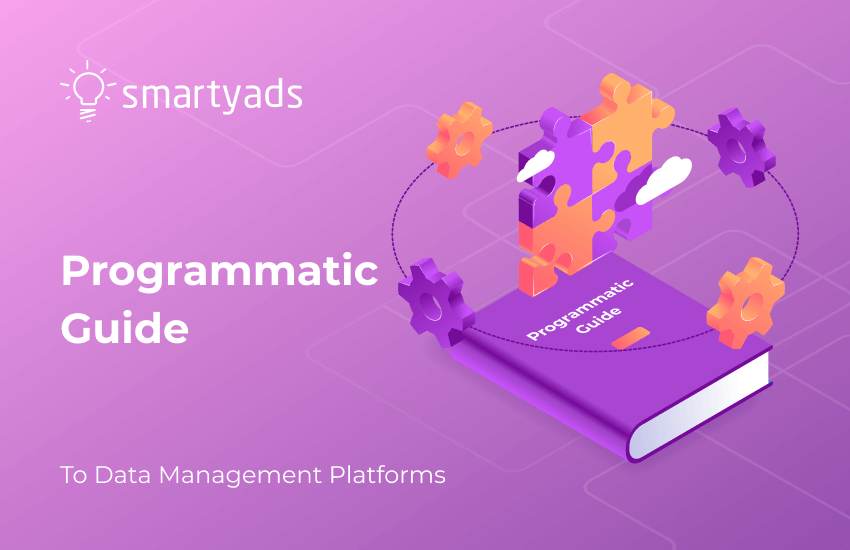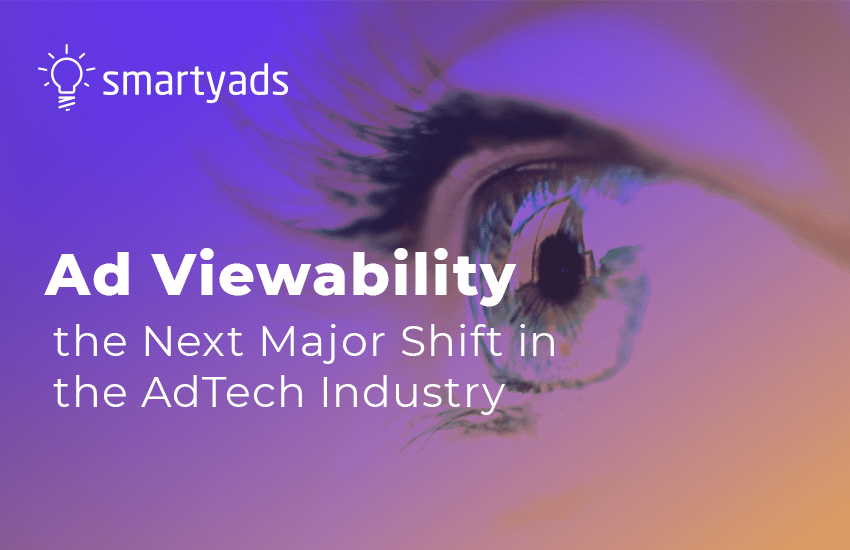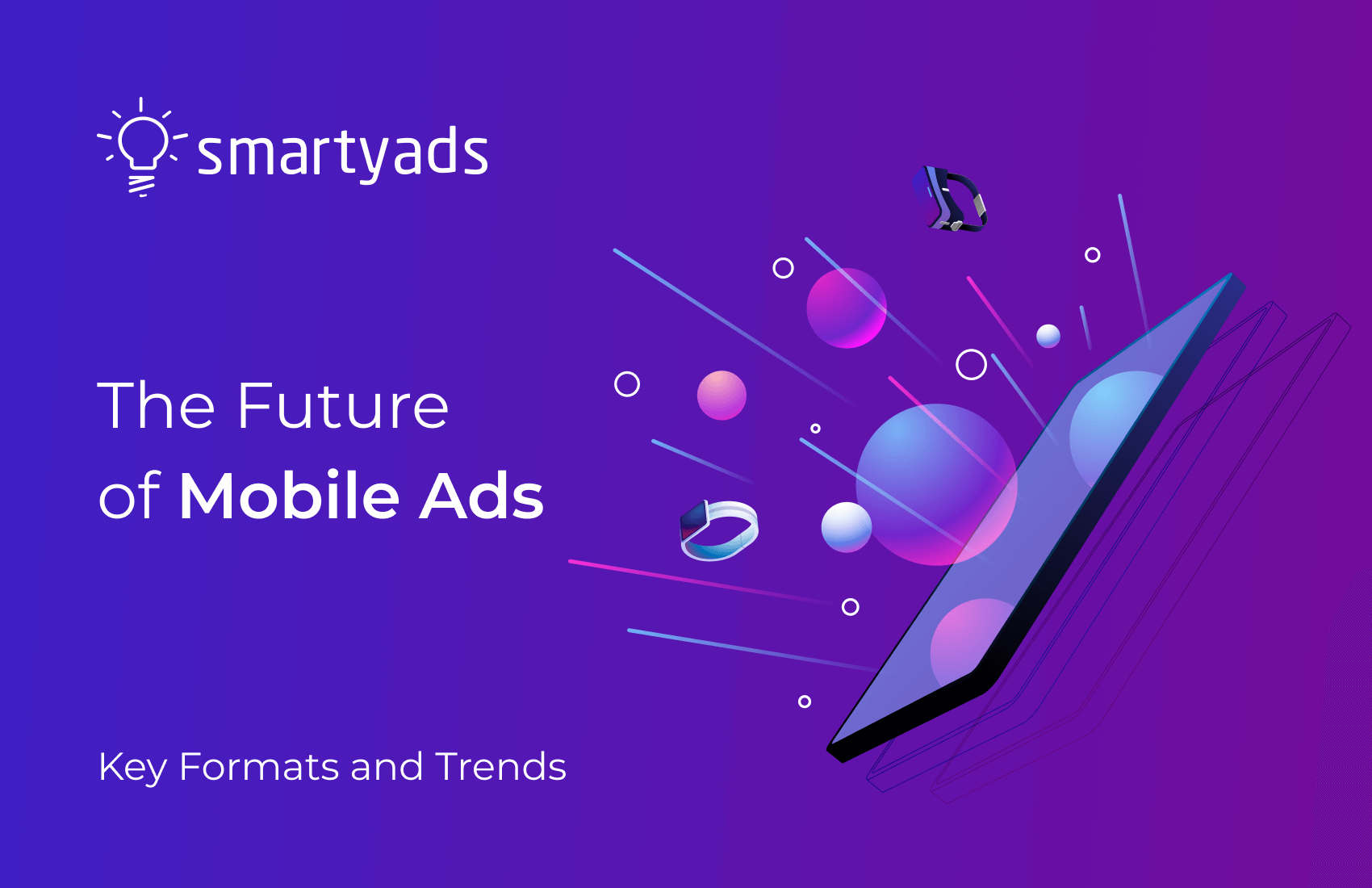There are several types of pricing models for digital programmatic advertising and online advertising. They include CPI, CPC, CPA, and, of course, CPM (CPT) — the most popular method for pricing web ads used in digital marketing and display advertising.
CPM has evolved from a mere measure of ad cost inherent in print advertising into a powerful instrument to drive better outcomes and shape the digital advertising strategy.
If you are still wondering, “What does CPM mean in advertising?” — this article is definitely for you. Down below, you will find a comprehensive overview of this indispensable metric: everything from the basic definition of the term to its benefits and best practices in the realm of digital advertising.
What is CPM in advertising?
Let’s start with some basics. So, what does CPM stand for in advertising?
CPM is an abbreviation that stands for "cost per mille," where "mille" is a Latin word that stands for "thousand." CPM is the price advertisers pay for every thousand impressions, aka the appearance of their ads on a certain website or resource. Cost per thousand is just another way to call this model; thus, these two notions are interchangeable.
This key metric is paramount in measuring the effectiveness of marketing and advertising campaigns. The CPM model is represented in almost every ad network, so it is among the most popular and requested metrics today. Now, let’s see how to calculate CPM in advertising with a simple formula.
CPM = cost of campaign ÷ (impressions ÷ 1000)
or
CPM = (cost of campaign ÷ impressions) × 1000
For instance, if you spent $300 on your ad campaign and it served 50,000 impressions, your CPM is $6.

Importance of CPM in digital marketing and advertising landscape
In the dynamic digital world, CPM (Cost per Thousand Impressions) is of immense importance to advertisers and marketers. Here's why CPM meaning in advertising is crucial:
- It boosts brand visibility and awareness;
- It efficiently reaches specific target audiences;
- It provides cost control and predictability;
- It offers valuable insights into brand exposure;
- It provides flexibility and scalability;
- It complements performance marketing campaigns;
- It integrates with retargeting and remarketing efforts.
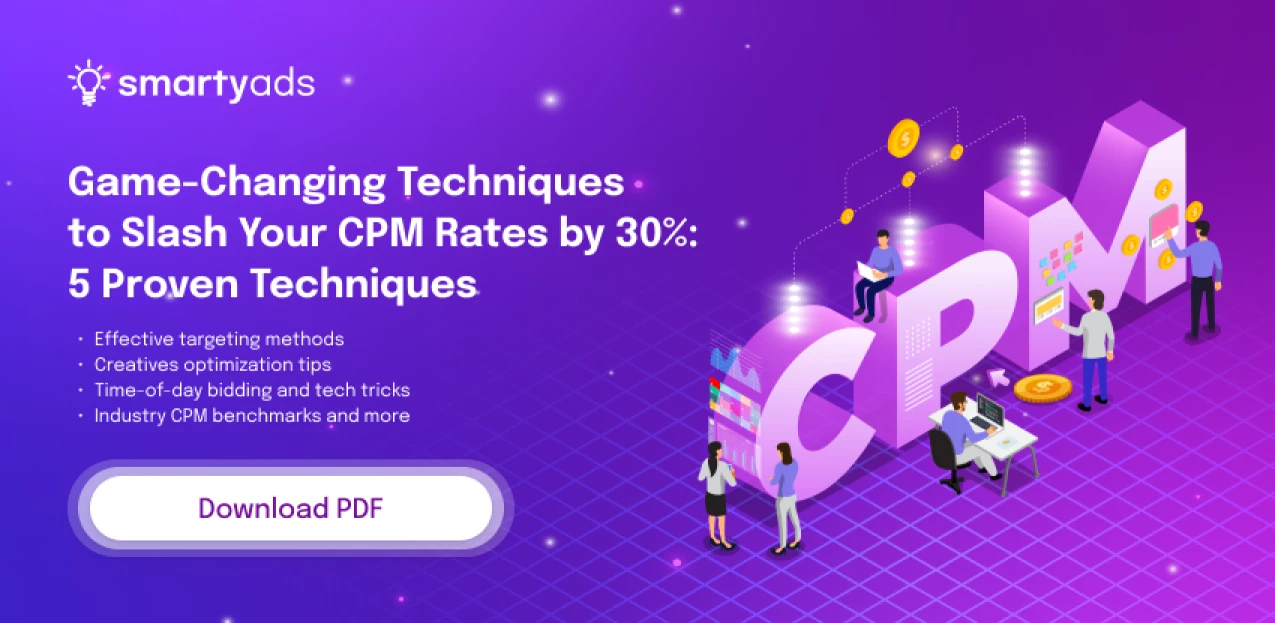
CPM and other pricing methods: how it is different from CPC and CPA
The CPM pricing model is popular in Internet advertising because it is simple — users are not expected to take any actions, like clicking on online ads, installing apps, or buying something. Let us now look at other online advertising pricing models and see how CPM differs. There are following website advertising rates:
CPM vs. CPC
In CPM ads, marketers pay for every thousand impressions their ad receives, regardless of whether users click on it. It focuses on brand exposure and reaching a wide audience.
In CPC (cost per click) advertising, marketers pay each time a user clicks on their ad. This model emphasizes driving traffic and actual user engagement. Advertisers only pay when someone interacts with their ad by clicking on it.
CPC vs. CPA
CPC and CPA pricing models stand for cost per click and cost per acquisition, respectively. Typically, with CPC, an advertiser or marketer pays only for the number of clicks the ad generates.
In the CPA model, display advertisement is supposed to generate sales. For such campaigns, marketers pay only when the transaction is made on the web page.
CPM vs. CPA
CPM pricing is based on the number of impressions without requiring a specific action from users. It aims to increase brand visibility and awareness.
CPA advertising charges are based on specific actions or conversions, such as purchases, sign-ups, or submission forms. Advertisers pay only when users perform the desired action.
CPM vs. CPV
CPM advertising charges are based on impressions, meaning each time an ad is displayed or loaded on a web page or app. The focus is on the potential exposure of the ad to users.
CPV (cost per view) advertising charges are based on the number of views or interactions with video ads. Marketers pay when a user watches a certain portion of a video ad or engages with it in a predefined way.

Benefits of CPM in advertising for publishers and developers
Mitigated risks
CPM is preferable by publishers as with this online advertising model, they don't risk anything; ad revenue is counted after each ad serving.
No additional efforts
It is easier to monetize inventory with the CPM model. CPM is simple; however, to serve advertisements on the CPM advertising platform, the publisher's advertising inventory should reach a particular bar of daily user views.
No need to gather website keywords
With CPM ads, publishers don't even have to select keywords for their website targeting. Programmatic advertising is created to personalize each impression for every viewer, so keywords are not needed.
Performance is easy to count
No metric is easier to measure and evaluate than CPM advertising, meaning the performance can be tracked by applying our simple formula provided above. Having a good grasp on CPM will enable marketers to make well-informed business decisions, optimize budgets, and further shape their strategy.
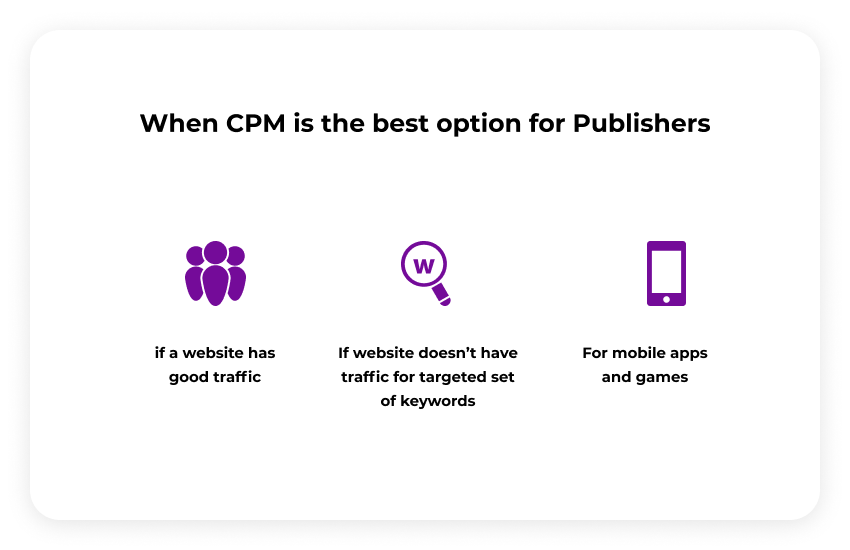
Why should advertisers use CPM strategies?
So what does CPM mean in marketing and why are CPM strategies so frequently used by professionals? Here's what media buyers say:
- To raise brand awareness, recall, and get high traffic
CPM is a perfect metric when building a strong audience and raising brand awareness. Cost-per-click ad campaigns, meanwhile, will better suit performance campaigns.
- To easily reach the right audiences
Using this model to build your target audience persona and introduce your brand to them is also a good move.
- To save on budget
This common method is more affordable than CPC and CPA. The cost per impression is lower than the cost per click, so companies pay less.
For instance, advertising costs $20 (CPM campaign), and the total value for a pay-per-click campaign is $20 (for, let's say, 50 clicks on the advertisement). As soon as you get 50 clicks, the CPC campaign is finished. While it's hard to predict how many ad clicks the CPM campaign will generate; theoretically, you can get up to 1000 clicks on the ad for the same money.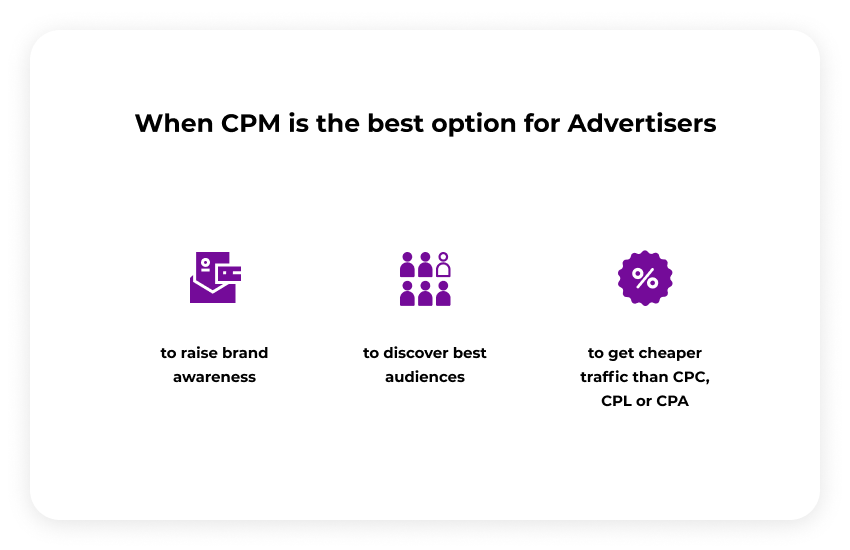
Why run CPM campaigns on DSPs?
For programmatic advertising platforms like demand-side platforms, delivering the right marketing messages to the right users at the right site or app is easy.
There are numerous reasons to choose DSPs:
- It's easy to analyze ad performance — you can choose a period and see how many digital views you obtained during that time, how many clicks those generated, win rates, etc.;
- There are plenty of formats available for the cost per thousand (CPM) impression segment: banners, display ads, in-app and mobile ads, CTV, etc.;
- Certain DSPs have specifically developed functionality that optimizes the total cost per thousand.
How to optimize the CPM impressions you bid on?
On SmartyAds DSP, advertisers can set up a bid cap so that the system will take it as a maximum bid threshold it never exceeds.
In addition to this, SmartyAds DSP has a feature called CPM optimizer. With this function activated, media buyers (advertisers) will receive more impressions for the same CPM.
During the real-time bidding process, it learns the specifics of the purchased ad placements and the dynamics of the bidding process. It will automatically adjust the CPM bid price, decreasing the price per each when possible (just for a sufficient optimal level to win the impression).
Ad Fraud and Brand Safety
The main concerns related to CPM advertising lie in ad fraud and brand safety. Fraudulent impressions and non-human traffic can cast a shadow over the ad campaign's effectiveness and, as a result, ROI. Additionally, the risk of appearing on low-quality websites is still pretty high, which can compromise the brand's reputation and undermine the marketing efforts.
Not to let it happen, it’s crucial to understand how to prevent ad fraud and mitigate risks associated with these problems. First of all, it’s required to work with programmatic advertising platforms that use ads.txt, ads.cert, app-ads.txt, possess a TAG certification, and correspond to other traffic and seller verification standards. It’s worth noting that SmartyAds adheres to all industry safety standards, so while using our platform, you can leave all your worries behind.
Moreover, we also recommend creating internal security policies and procedures with a flow of steps that demonstrate how to prevent ad fraud in the future. These established rules can serve as a main touchpoint for employees, but it’s imperative to educate them continuously to detect ad fraud and preserve your brand image and clients’ trust.
Best Practices for CPM Ads
When launching a CPM advertising campaign, there are a few basic rules that must be followed to succeed:
Setting clear campaign objectives
Clearly define your goals and objectives before launching a campaign. Determine whether your focus is on brand awareness, reach, conversions, or another specific outcome.
Set measurable key performance indicators (KPIs) that align with your objectives, such as the number of impressions, click-through rates, or engagement metrics.
Monitoring and optimizing ad performance
Regularly monitor the performance of your CPM ads using analytics tools or platforms. Keep track of key metrics, such as impressions served, click-through rates, conversion rates, and engagement levels.
Analyze the data to identify trends, patterns, and areas for improvement. Determine which ad creatives, placements, or targeting options are performing well and which may need adjustments.
Optimize your ad campaigns based on insights gathered from data analysis. Make data-driven decisions to refine your targeting, adjust bidding strategies, or update ad creatives to enhance performance.
A/B testing and experimentation
Conduct A/B testing by running multiple versions of your ads simultaneously to identify the most effective elements. Experiment with different ad creatives, headlines, calls to action, ad placements, platforms, or targeting options to discover new opportunities for optimization.
Split your target audience into smaller segments and test different variations within each segment. Create a separate web page for each audience segment if needed. This allows you to gather insights on what resonates best with different audience subsets.
Continuously iterate and refine your ad campaigns based on the results of A/B testing and experimentation. Implement the learnings to improve your ad performance over time.
The Future of CPM Advertising
What is CPM in marketing and advertising’s future? Well, the landscape of digital advertising is very dynamic and evolves with the speed of lightning. However, we are pretty sure that CPM will preserve its special place in the advertising ecosystem. The potential of CPM advertising is immense, and we should expect even more in the years to come.
The advent of the latest technologies, such as AR, connected TV, and voice-activated devices, will surely impact the CPM advertising realm. These technologies not only reshape the way consumers interact with content but also promise to revolutionize ad engagement, offering unprecedented opportunities to captivate and grab the attention of audiences.
All this will require some bold decisions and innovative approaches to CPM advertising. So, the best advice for now is to stay flexible and adaptable to stay ahead of the competition, embrace the changes, and conquer this unpredictable yet fascinating market.
Summing it up
As you can see, CPM meaning in digital marketing and advertising is immense. It serves as one of the key metrics that enables you to measure the success of your advertising campaigns effectively. SmartyAds DSP is a user-friendly platform with vast functionality that will facilitate your advertising journey to attain tangible results with no effort. It allows you to seamlessly create, launch, and analyze campaigns to promote your products or services and reach desired audiences from all over the world.
Moreover, the DSP platform follows all the industry safety measures to prevent ad fraud and ensure the highest quality of traffic for our users. On top of that, our DSP makes it possible to set up the desired CPM so you can have predictable spendings that fit your advertising budget. Our recently released adaptive CPM feature will automatically adjust your bids to the optimal level, thus generating more impressions without the risk of overpaying.
Start getting benefits from the CPM campaign on SmartyAds DSP!

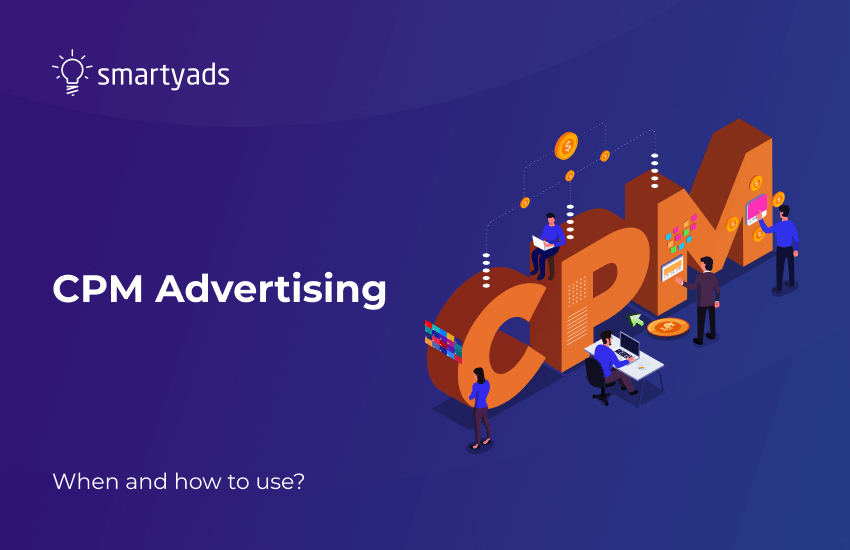
.webp)
